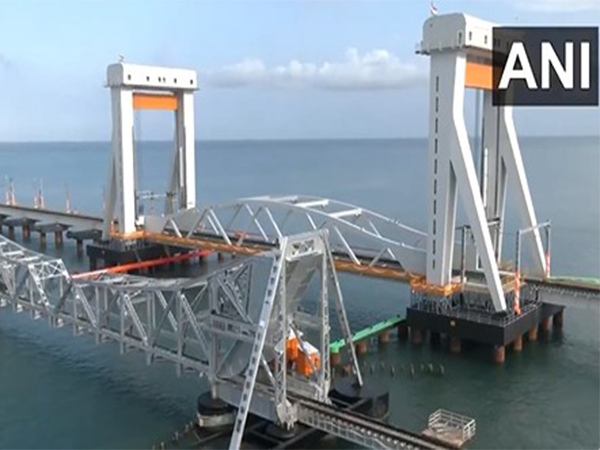
Ramanathapuram ( Tamil Nadu ) [India], April 6 (ANI): In celebration of Ram Navami, Prime Minister Narendra Modi plans to launch India's inaugural vertical lift sea bridge, the New Pamban Bridge in Ramanathapuram, Tamil Nadu , on Sunday.
The 2.07-kilometre-long New Pamban Bridge , crossing the Palk Strait in Tamil Nadu , serves as a testimony to India's engineering expertise and forward-thinking infrastructure advancement, according to a statement from the Ministry of Railways.
The bridge features a single vertical lift span measuring 72.5 meters, accommodating two tracks. Approaching this structure consists of 88 spans, each 18.3 meters long, made from steel plate girders designed initially for a solitary track.
The history of the bridge dates back to 1914 when British engineers built the initial Pamban bridge. This early version featured a cantilever design—a lengthy section made either of metal or timber extending from a supporting wall—to accommodate a Scherzer Rolling Lift span, linking Rameswaram Island to the Indian mainland. Nonetheless, the recently approved bridge, established in 2019, stands three meters taller than the current structure, enhancing maritime connections.
The bridge has acted as a vital connection for devotees, visitors, and commerce.
"The severe maritime conditions and increasing transport requirements called for a contemporary approach. Consequently, in 2019, the Central government approved the development of an advanced, forward-thinking substitute," stated the Ministry’s announcement.
The New Pamban Bridge The construction was carried out by Rail Vikas Nigam Limited (RVNL), which is a Navratna Public Sector Undertaking under the Railway Ministry. RVNL made sure that the bridge complies with stringent speed, load, and marine standards. This newly built bridge improves accessibility and highlights India’s prowess in building safe, durable, and innovative transportation infrastructures.
The ministry stated that the bridge was built using stainless steel reinforcements, top-quality protective paint, and completely welded connections. An additional layer of protection comes from a specialized polysiloxane coating, which shields it against rust, guaranteeing durability in the challenging coastal conditions.
By the dawn of the 21st century, the ancient bridge was struggling to cope with contemporary travel requirements. Growing traffic volumes, along with an urgent demand for enhanced speed and safety links, led the authorities to conceive a cutting-edge facility—robust, forward-thinking, and equipped with state-of-the-art technology.
The development of an advanced sea bridge designed to handle increasing traffic, guarantee longevity, and enable easier marine passage. New Pamban Bridge The statement indicated that it was designed to overcome the shortcomings of its predecessor and to facilitate improved regional connections and economic development.
The initial bridge from 1914 played a crucial role in commerce and religious journeys but failed to meet the requirements of contemporary railway needs. Considering the area’s frequent earthquakes, storms, and saltwater damage, officials emphasized the necessity for a robust and cutting-edge substitute structure.
The ministry stated that building the new Pamban Bridge came with many hurdles, including various environmental issues and complex logistics. The challenging conditions of the Palk Strait—such as rough seas, powerful gusts, and erratic climate patterns—posed significant problems during construction. Moreover, the area’s vulnerability to storms and earthquakes required thorough preparation and sturdy engineering.
In the end, the solution involved deploying the lift span girder from pier to pier utilizing the 'Auto Launching Method Based on Relationship Principle.' This approach was developed by Suntech Construction Engineering Consultants and confirmed by IIT Madras.
For transport, assembly, and the final welding processes—which occurred post-painting and following the final inspection—the segments were transported via trucks to Pamban. There, they utilized a provisional platform equipped with two Electric Overhead Travelling (EOT) cranes for girder assembly. The welding took place inside dedicated shelters, while joint inspections were carried out using Phased Array Ultrasonic Testing (PAUT). Corrosion prevention was finalized through metal spraying followed by additional paint application.
Although the new Pamban Bridge marks India's first vertical lift sea bridge, it bears resemblance to other internationally renowned structures celebrated for their innovative technology and distinctive architecture.
The ministry stated that among them are the Golden Gate Bridge in the U.S., Tower Bridge in London, and the Oresund Bridge connecting Denmark and Sweden. (ANI)
.png)